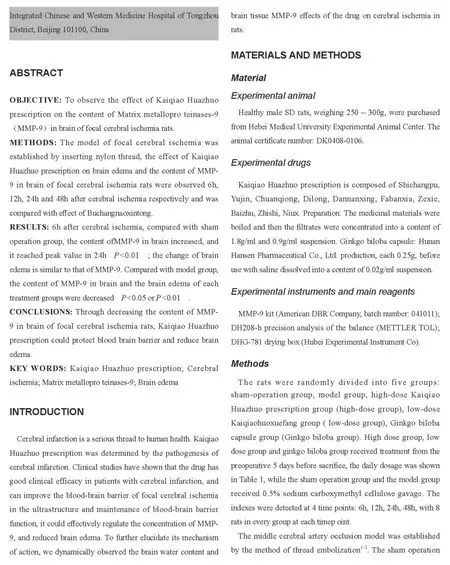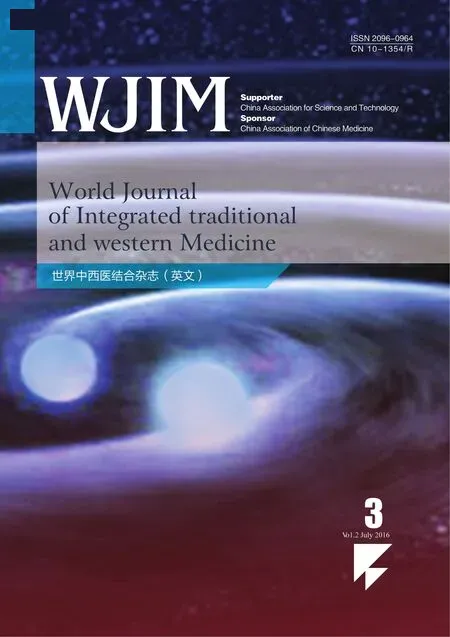Effects of Kaiqiao Huazhuo prescription on the content of Matrix metallopro teinases-9 in brain of focal cerebral ischemia rats
Su Fengzhe(蘇鳳哲), and Xu cong(徐聰)
Effects of Kaiqiao Huazhuo prescription on the content of Matrix metallopro teinases-9 in brain of focal cerebral ischemia rats
Su Fengzhe(蘇鳳哲), and Xu cong(徐聰)

group only isolated and exposed the blood vessels. The common carotid artery and external carotid artery were not ligated. The rats with that left upper limb flexion, left rotation when walking, left paralysis of the limb were chosen as the success of the experiment, otherwise regarded as plug blocking failure. The rectal temperature was monitored during the procedure and maintained at 36.5~37.5℃.
The water content of the brain was measured. The right brain of the rats was weighed, and the rats were dried in a constant temperature oven at 90 for 60 hours. The brain water content was calculated according to Elltot’s formula. Water content = (wet weight-dry weight) / wet weight×100%. The level of MMP-9 in brain tissue was measured by ABC-ELISA. The expression of MMP-9 in brain tissue was measured by MTT assay. 9, measured with microplate reader OD value indirectly ref l ects amount of change.
Statistical analysis
RESULTS
As showed in Table 1, compared with the sham-operated group, the water content of the brain tissue in the model group increased significantly (P<0.01) after 6h of focal cerebral ischemia (P<0.01), and the content of water in the brain tissue of rats with focal cerebral ischemia (P<0.01). Compared with the model group, the water content of brain tissue in each treatment group decreased (P<0.05), and the water content of brain tissue increased with the prolongation of ischemia time (P<0.01). The brain water content of the high dose group was significantly lower than that of the Ginkgo biloba group (P<0.05) at 6h after focal cerebral ischemia.
As indicated in Table 2, compared with the sham-operation group, the expression of MMP-9 in the brain tissue of model group increased at 6 hours after focal cerebral ischemia (P<0.01 or P<0.01). Compared with the model group at the same time, the levels of MMP-9 in each treatment group were decreased (P<0.05 or P<0.01).
Table 1. Comparison among the groups on Cerebral Water Content

Table 1. Comparison among the groups on Cerebral Water Content
Notes: Compared with the model group,*P<0.05,**P<0.01.Compared with the Ginkgo biloba group,△P<0.05.
Group(g/Kg)n6h12h24h48h Sham-operation877.16±0.58**77.21±0.62**77.19±0.69**77.20±0.65**Model878.30±0.6581.12±1.6983.56±0.5983.02±0.89 Ginkgo biloba0.3877.31±0.9178.97±0.89*82.01±0.98*82.13±0.58 High-dose 18875.98±0.79*△77.87±1.09**81.02±0.95**81.43±0.56**Low-dose 9876.96±0.9980.01±0.9181.52±1.28**81.81±0.82**

Table 2.Comparison among the groups on MMP-9
DISCUSSION
Cerebral infarction belongs to "stroke" category in traditional Chinese medicine and it is clinical common disease. After many years of clinical observation, phlegm and blood stasis, brain orifices stasis were found as the pathogenesis of the disease. Kaiqiao Huazhuo prescription is composed of Shichangpu, Yujin, Chuanxiong, Dilong, Dannanxing, Fabanxia, Zexie, Baizhu, Zhishi, Niuxi. Shihangpu and Yujin as sovereign drugs have functions of opening the orifices to regain consciousness. Modern pharmacological studies have shown that: Shichangpu can improve EEG, protect brain cells, significantly inhibited cerebral cortex and hippocampal neuronal apoptosis, inhibit bax gene expression, and promote bcl-2 gene expression ef f ect4,5. The minister drug is Chuanxiong. Modern research shows that the mechanism of Chuanxiong in preventing and treating cerebral ischemia is related to enhancing the activity of dynorphin A1-13-like immunoreactive ubstance in plasma and brain spinal cord, restraining the activation of platelets in cerebral ischemia and correcting the imbalance of TXA2-PGI2 in circulation.6,7Dilongand Jiangcan free the block. Banxia, Gualou and Dannanxing have the functions of drying dampness and resolve phlegm. Baizhu and Zhishi regulate Qi and invigorate spleen. Zexie promotes diuresis and percolates dampness. Huainiuxi makes the blood flow down as a guide drug. With all the ingredients combined together, the whole formula treats the root and the tip, achieve the success of resolving dampness and phlegm, opening the orif i ces to regain consciousness, promoting blood circulation and reoving blood stasis.
Kaiqiao Huazhuo prescription can reduce the expression of MMP-9 in brain tissue of rats with cerebral infarction and reduce cerebral edema.
Matrix metalloproteinase-9, a family of matrix metalloproteinases, is capable of degrading and remodeling extracellular matrix. Under physiological conditions, matrix metalloproteinases (MMPs) are present as inactive forms of zymogen, which are activated by inf l ammatory mediators during cerebral ischemia-reperfusion. It has been shown that MMP-9 expression is increased after cerebral ischemia-reperfusion, and the blood-brain barrier (BBB) is destroyed by degeneration of basement membrane and connexin, leading to vasogenic brain edema. Romanic8and other reports of persistent focal cerebral ischemia in mice 1h, showing increased activity of ischemic area of MMP-9, 24h to maximize; our findings and the results were similar to the focal cerebral ischemia 6h (P <0.01). The expression of MMP-9 in brain tissue of rats in model group increased to the peak at 24h, and the dynamic changes of brain tissue water content were synchronized with MMP-9, the formation of brain edema during ischemia may be related to the increased expression of MMP-9.
Ginkgo biloba was commonly used as proprietary Chinese medicine for the clinical treatment of cerebral infarction, it had good effect in treating cerebral infarction at all stages. Kaiqiao Huazhuo prescription was similar to Ginkgo biloba in in the drug type and scope of treatment, which meant they were comparable, so the Ginkgo biloba was selected in the control group. This study shows that, compared with the model group, Kaiqiao Huazhuo and Ginkgo biloba can reduce brain tissue MMP-9, reduce brain water content, indicating that both can reduce brain edema.
REFERENCES
1 Asanhi M, Wang X, Mori T, et al.Effects of Matrix metallopro teinases-9 gene knock out on the proteolysis of blood brain barrier and white matter component after cerebral ischemia.J Neurosci,2001,21(19):7724-7732.
2 Zea Longa EL,Weinstein PR,Carlson S,et al. Reversible middle cerebral artery occlusion without craniectomy in rats. Stroke,1989(20):84.
3 Yang Shifang, Min Baozhen. A simple method for quantitative measurement of the range of experimental cerebral infarction in rats. Chinese Journal of Pathophysiology, 1996,12(1):103-104.
4 Fang Yongqi, Li Ling, Zou Yanyan. Ef f ect of Shichangpu on brain electroencephalogram and cerebral edema in rats with cerebral ischemia-reperfusion injury. Zhongguo Zhong Ji Ji Zheng,2003,12(1):55.
5 Fang Yongqi,Kuang Zhongsheng,Xie Yuhui.Effects of Acorus gramineus on Apoptosis of Neuronal Cells in Rats with Cerebral Ischemia-Reperfusion Injury. Journal of Modern Traditional Chinese and Western Medicine,2002,11(17):126.
6 Liuzhong, Shi Yinmian, Chen Daren. Ef f ects of Ligusticum chuanxiong Hort on the content of dynorphin A1-13 in plasma and cerebrospinal fluid of rabbits with acute experimental cerebral ischemia. Zhong Xi Yi Jie He Za Zhi, 1990,10(3):160.
7 Liuzhong, Shi Yinmian. Ef f ects of Ligusticum chuanxiong Hort on the contents of β-TG, PF4 and TXB2, 6-keto-PGF1α in plasma of acute experimental cerebral ischemia rabbits. Zhong Xi Yi Jie He Za Zhi,1990,10(9):543.
8 Romanic AM,White RF,Arleth AJ,et al. Matrix metalloproteinase expression increases after cerebral focal ischemia in rats: inhibition of matrix metalloproteinasc_9 reduces infarct size. STROKE,1998(29):1020-1030.
(Accepted: June 19, 2016)
 World Journal of Integrated Traditional and Western Medicine2016年3期
World Journal of Integrated Traditional and Western Medicine2016年3期
- World Journal of Integrated Traditional and Western Medicine的其它文章
- A medical understanding on the wuxing theory in cell
- Clinical ef f ects of acupoints moxibustion therapy on postsurgical gastroparesis syndrome after resection of esophageal cardia cancer
- Meta-analysis about Western Medicine combined with activating blood drugs on modulating blood glucose and lipids in diabetic patients
- A randomized, controlled trial of Shutangluo fang in treating painful diabetic peripheral neuropathy
- INSTRUCTION FOR AUTHORS
- Analysis of the features of TCM and western medicine in the diagnosis and treatment of subclinical hypothyroidism characteristics
